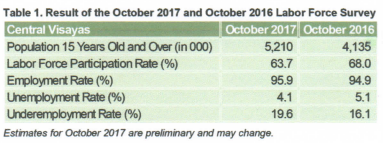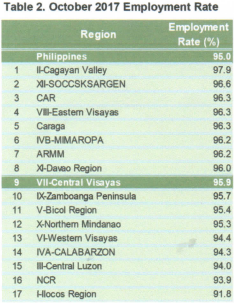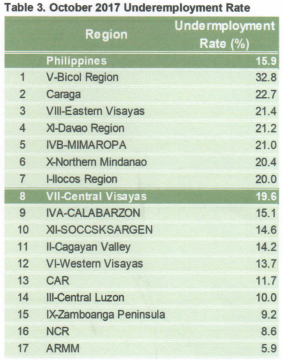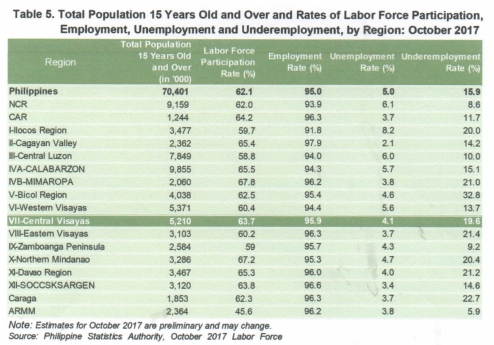The Labor Force Survey is one of the nationwide survey of households undertaken quarterly which provides up-to-date information on the Philippine labor force and its characteristics. This survey gathers data on the demographic and socio- economic characteristics of the population and aims to provide a quantitative framework for the preparation of plans and formulation of policies affecting the labor market.
From the result of the October 2017 Labor Force Survey, Central Visayas has 5,210,000 total population of 15 years old and over wherein 63.7 percent were engaged in the Labor Force also known as the Labor Force Participation Rate (Table 1).

The country’s employment rate in October 2017 was estimated at 95.0 percent. Central Visayas with employment rate of 95.9 percent was significantly higher than the national figure which ranked 9th among the country’s 17 regions (Table 2).

The labor force population consists of the employed and the unemployed 15 years old and over.
In October 2017, workers were grouped into three broad sectors, namely, agriculture, industry and services sector. Workers in the services sector comprised the largest proportion of the population who are employed. Workers in the agriculture sector comprised the second largest group of the total employed while those in the industry sector are the smallest group.
Employed persons fall into any of these categories: (1) wage and salary workers, (2) self-employed workers without any paid employee, (3) employers in own family-operated farm or business, and (4) unpaid family workers. Wage and salary workers are those who work for private households, private establishments, government or government-controlled corporations, and those who work with pay in own family-operated farm or business.
Employed persons are classified as either full-time workers or part-time workers. Full-time workers refer to those who worked for 40 hours or more during the reference week, while those who worked for less than 40 hours were considered part-time workers.
By definition, employed persons who express desire to have additional hours of work in their present job, or to have additional job, or to have a new job with longer working hours are considered underemployed.
In October 2017, the underemployment rate, was estimated at 19.6 percent for Central Visayas (Table 3).

Region VII ranked 8th among regions with highest underemployment rate for October 2017.
Underemployed persons who work for less than 40 hours in a week are called visibly underemployed persons.
Meanwhile unemployed persons include all those who, during the reference period, are 15 years old and over as of their last birthday who have no job/business, currently available for work and actively looking for work.
Also considered as unemployed are persons without a job or business who are reported not looking for work because of their belief that no work was available or because of temporary illness/disability, bad weather, pending job application or waiting for job interview.
The unemployment rate in October 2017 was estimated at 4.1 percent. There were eight regions which have an unemployment rate higher than the Region VII figure.
The October 2017 Employment Rate is taken from the preliminary result of the October 2017 Labor Force Survey conducted by Philippine Statistics Authority (Table 5).

TECHNICAL NOTES
- Starting April 2005, the new unemployment definition was adopted per NSCB Resolution Number 15 dated October 20, 2004. As indicated in the said resolution, the unemployed include all persons who are 15 years and over as of their last birthday and are reported as: (1) without work and currently available for work and seeking work; or (2) without work and currently available for work but not seeking work for the following reasons:
1. Tired/believed no work available
2. Awaiting results of previous job application
3. Temporary illness/disability
4. Bad weather
5. Waiting for rehire/job recall
- Starting January 2012 LFS, the codes for industry adopted the 2009 Philippine Standard Industrial Classification (PSIC). Prior to this, codes for industry used the 1994 PSIC.
- Question on vocational course was introduced in the January 2012 LFS questionnaire.
- Starting April 2016 round, the Labor Force Survey (LFS) adopted the 2013 Master Sample Design, with a sample size of approximately 44,000 households.
- The 2012 Philippine Standard Occupational Classification (PSOC) was adopted starting April 2016. The 1992 PSOC had been used prior to April 2016.
- Starting with the April 2016 LFS round, the population projections based on the 2010 Census of Population and Housing (2010 CPH) has been adopted and generate the labor statistics.
- In January 2017 round, Computer Aided Personal Interviewing (CAPI) using Tablet was utilized in the LFS enumeration.
- Overseas Filipino Workers are not considered part of the labor force in the Philippines. Hence, in the LFS, data on economic characteristics of household members who are overseas workers are not collected. For the LFS reports, they are excluded in the estimation of the size of working population, that is, population aged 15 years and older, and in the estimation of the labor force.
(SGD.) ENGR. ARIEL E. FLORENDO
Regional Director

